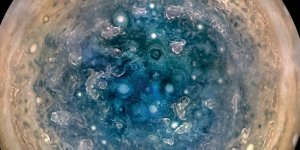| News / Space News |
Astronomers Piece Together First Image of Black Hole
After training a network of telescopes stretching from Hawaii to Antarctica to Spain at the heart of our galaxy for five nights running, astronomers said Wednesday they may have snapped the first-ever picture of a black hole.

This artist's concept illustrates a supermassive black hole. ![]()
It will take months to develop the image, but if scientists succeed the results may help peel back mysteries about what the universe is made of and how it came into being.
“Instead of building a telescope so big that it would probably collapse under its own weight, we combined eight observatories like the pieces of a giant mirror,” said Michael Bremer, an astronomer at the International Research Institute for Radio Astronomy (IRAM) and a project manager for the Event Horizon Telescope.
“This gave us a virtual telescope as big as Earth — about 10,000 kilometers (6,200 miles) in diameter,” he told AFP.
The bigger the telescope, the finer the resolution and level of detail.
The targeted supermassive black hole is hidden in plain sight, lurking in the center of the Milky Way in a region called the Sagittarius constellation, some 26,000 light years from Earth.
Dubbed Sagittarius A* (Sgr A* for short), the gravity- and light-sucking monster weighs as much as four million Suns.
Theoretical astronomy tells us when a black hole absorbs matter — planets, debris, anything that comes too close — a brief flash of light is visible.
Black holes also have a boundary, called an event horizon.
The British astronomer Stephen Hawking has famously compared crossing this boundary to going over Niagra Falls in a canoe: if you are above the falls, it is still possible to escape if you paddle hard enough.
Once you tip over the edge, however, there’s no going back.
The Event Horizon Telescope radio-dish network is designed to detect the light cast-off when objects disappear across that boundary. (Tasnim News Agency)
YOU MAY ALSO LIKE



